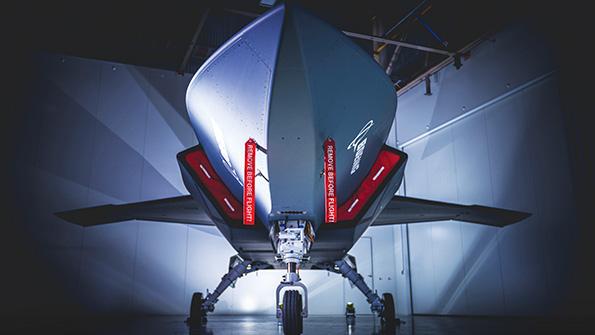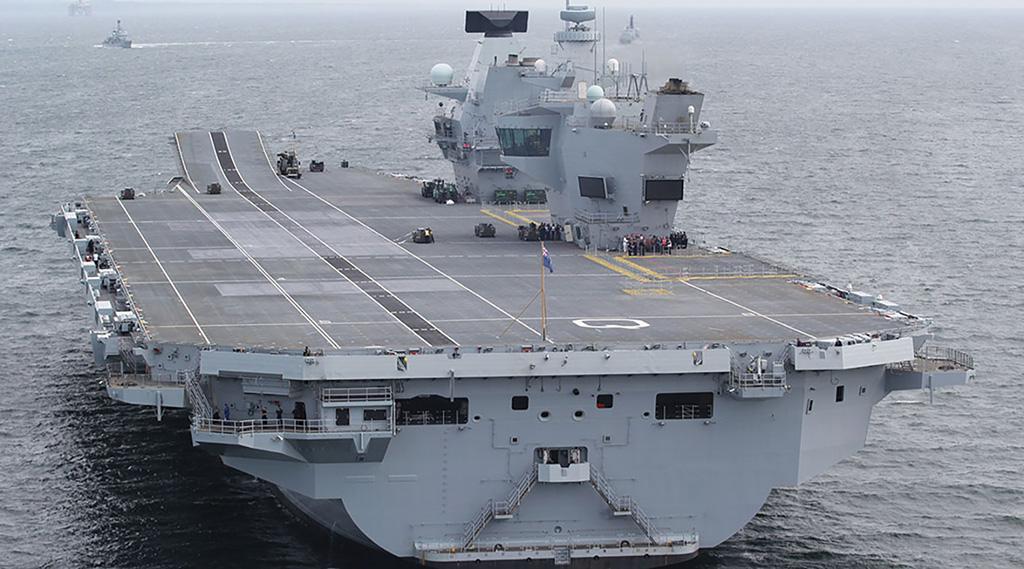
Boeing may accelerate development of its Airpower Teaming System (ATS) to begin deliveries before the middle of the decade, amid what it says is unexpectedly strong early interest in the loyal-wingman drone. The ATS is evidently the basis of the company’s offer for the UK’s Lightweight Affordable Novel Combat Aircraft (LANCA) initiative.
- RAF sees LANCA derivative aboard aircraft carriers
- First ATS prototype will soon taxi
The possibility of operating the ATS or a derivative from British aircraft carriers is raising the question of how the type is intended to be deployed, an issue that Boeing has declined to discuss in detail. Evidence points to one possibility for land operation being containerized dispersal by road, rocket-assisted launch from a rail, and recovery to a runway or road.
The first of three ATS prototypes will taxi soon, says the program chief, Shane Arnott, reiterating that the first flight is due this year.
Boeing is developing the ATS in Australia with support from the Royal Australian Air Force, for which the program is research work on manned-unmanned teaming. For Boeing, it is creating a product for the international market. The company unveiled the ATS in February 2019 and rolled out the first prototype in May 2020.
Arnott said in May that the first-production ATS could be completed around the middle of the decade or a little earlier. Speaking to reporters on July 16, he said the schedule had not changed. But he then referred to high interest in the product and added that the schedule might be advanced. “Everyone is trying to solve the same problem” of achieving mass—large numbers—in an air campaign, he says, adding that many military aviation services were reaching out to see if the ATS could solve the issue.
Kratos, builder of the conceptually similar XQ-58 Valkyrie drone, has also attracted interest from possible buyers apart from its primary customer, the U.S. Air Force.
For LANCA, Boeing Autonomous Systems is working with Marshall Aerospace and Cranfield University and submitted a proposal in the northern spring. The Boeing-led team was one of three chosen for Phase 1. One or two of those teams will be selected for Phase 2, called Mosquito, a £30-50 million ($38-64 million) initiative that will lead to the candidates producing flightworthy demonstrators for a UK-based flight-test program.
Since Arnott says LANCA is a key activity for the ATS program, it is clear that the Boeing proposal to Britain is based on the loyal wingman. “Safe to say that the problems being presented in Australia are similar to the problems being presented in the UK,” Arnott says. “LANCA and Mosquito have similar requirements [to Australia]: an affordable platform to be developed in one-fifth of the time.”
Australia has allowed Boeing to share ATS design materials with Britain. Arnott would not comment on the level of information released. Discussions with the Royal Air Force (RAF) and its Rapid Capabilities Office have extended to the Royal Navy, he says.

The RAF envisions an aircraft derived from LANCA’s Mosquito phase being used on the Royal Navy’s aircraft carriers Queen Elizabeth and Prince of Wales, alongside Lockheed Martin F-35B Lightnings, Air Chief Marshal Mike Wigston said at the RAF’s Air and Space Conference during a webinar on July 15.
But how could the ATS operate at sea? Indeed, how is it supposed to operate on land?
Asked about the apparent reliance of the ATS on vulnerable airfields, Boeing autonomous aviation executive Jerad Hayes told Aviation Week in May: “We recognize the need for the system not to be bound by traditional runway operations to meet the rising-threat conops [concept of operations]. This is core to the ATS design to enable that flexibility of distributed operations to the customer.”
The landing gear for the ATS is clearly not designed for rough fields, so distributed operation implies dispersal by truck and rocket-assisted takeoff from a mobile rail launcher; less flexibly, it might also use straight stretches of road. Rail launch has been used by many aircraft types for decades, including the Valkyrie. Boeing has been careful not to show the rear of the ATS. One reason could be to hide stealth features there, but another could be to avoid disclosing provision for a takeoff rocket or two.
The Valkyrie lands by parachute, but since the ATS has landing gear, it must be intended to recover to an airfield or a road. The Boeing type has a considerable range, presumably ferry range, of 3,700 km (2,000 nm), so it may be able to reach a safe airfield well behind its launch point.
The aircraft’s length is 11.7 m (38 ft.). The wing is built of two pieces, upper and lower, that appear to be unbroken from tip to tip. Conceivably, the wing could be removed and placed on top of the fuselage. The result: a package that might go into a 40-ft. shipping container for storage, transportation and deceptive deployment, with many empty containers lying about to keep an enemy guessing.
Compact stowage, probably stacked, would be valuable on an aircraft carrier.
An ATS probably could not take off from a deck at a useful weight on only turbofan thrust (likely not much more than 3,000 lb.). But rail launch, or perhaps a rocket-assisted deck run, could be used.
At first sight, deck landing looks improbable. But it may not be impossible for a drone that could conceivably achieve a precision touchdown at a low sink rate acceptable to its landing gear. If the carrier moved at 20 kt. (10.3 m/sec. or 38 ft./sec.) and a returning drone, lightly constructed and just about empty of fuel, could approach at 100 kt., touchdown speed relative to the deck would be 41 m/sec. Deceleration at 5 m/sec.2 by brakes alone would bring it to a halt in 170 m. The British carriers are 280 m long.
Also, the UK Defense Ministry last year called on industry to devise means of arrested recovery for shipboard drones. A further option for the long-legged ATS would be landing at an airfield.
Other bidders in Phase 1 of LANCA are Team Blackdawn, a consortium of Callen-Lenz working with Bombardier Belfast and Northrop Grumman UK; and Team Avenger, led by Blue Bear Systems Research and several undisclosed partners.
Low cost is a key ATS project aim: Boeing believes the aircraft must be cheap enough to be attrited. To this end, the company is heavily automating the production process—using robots to build these robots, Arnott says. Payloads, in detachable and swappable noses, may cost more than the rest of the airframe, he adds, though this will be up to the customer.
Since several ATS aircraft could together form one large array, very cheap sensor payloads could outperform elaborate, costly systems fitted to single aircraft, Boeing points out, apparently referring to passive radio.
As part of ATS development, Boeing has demonstrated an end-to-end mission in which three small jet drones autonomously took off, assembled in formation, departed from formation and landed. The speeds were up to 200 kph (108 kt.). This showed that the mission system worked, says Emily Hughes, director of Boeing Phantom Works International.
The test was done at Tara, west of Brisbane, Queensland, Australia. Boeing intends to use a specialist drone test facility that Qinetiq is setting up at Cloncurry in outback Queensland.







Comments